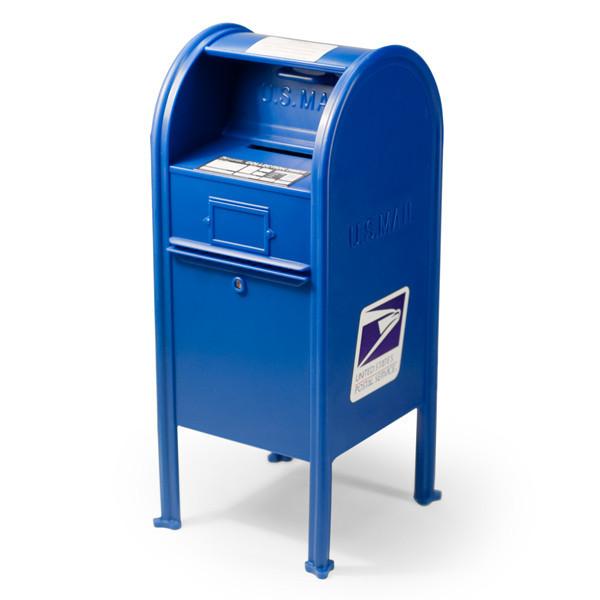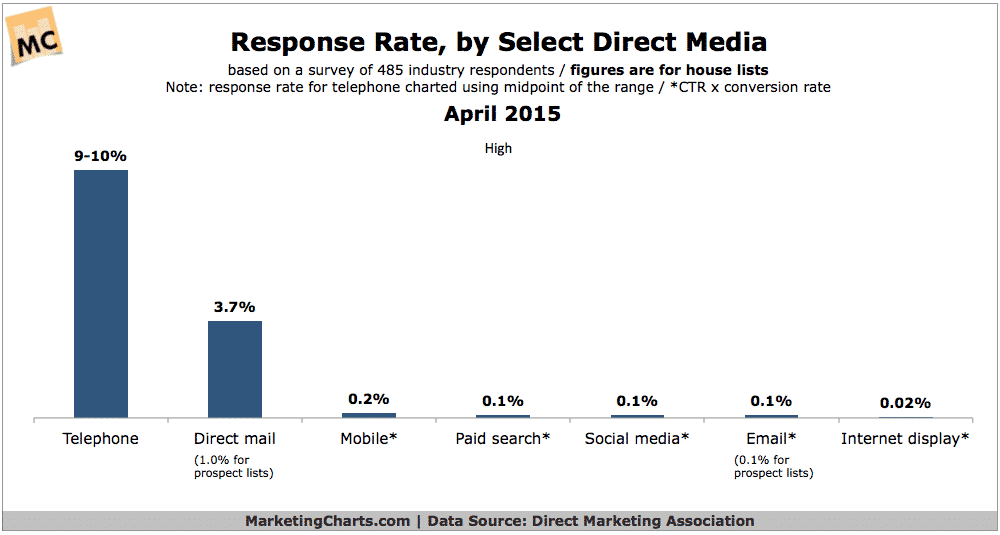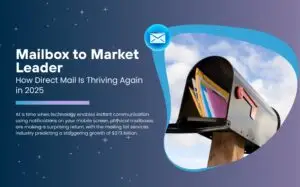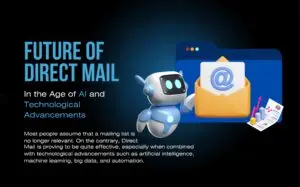What Is Direct Mail Marketing

Anyone with a mailbox receives some type of Direct Mail Marketing — be it a 15-percent-off coupon for Kohl’s or Macy’s sent exclusively to store credit-card holders, or a mailing from a local real-estate broker informing you of the current market value of your home.
Some other direct mail marketing strategies include postcards, coupons, special offers, advertising circulars, free newspapers, free trial CDs, catalogs, and pre-approved credit card applications.
Top Goals of Direct Mail Marketing
- Attract new customers
- Entice existing customers
- Inform and educate; Create a market or build a brand
- Introduce services or products
For example, our company uses Direct Mail as the main tool for its customers to reach their potential customers. We compile a weekly list of all new movers and new homeowners who had just moved to their new property, along with elaborate demographic information such as the square footage, price of the property, owner ethnicity and financial markers that altogether help a local business decide if and how to reach out to that new neighbor, welcome them to the neighborhood and make them an offer or simply inform them of their products and services in hope they come visit and check them out.
This form of advertising is cost effective, highly targeted (only reaches those that are likely to become customers) and is perceived in the public as respectful and not-intrusive (does not follow you around all over the web as you read your favorite websites or share photos of your family).
As recent facebook scandals have shown us – web advertising, while modern and wonderful, bears risks to the target audience by exposing their information in ways that have lead to many consumers not trusting it very much. And this is not even counting all the cases of fraud and phishing…. You don’t hear stories of fake-companies mailing people at home right? There’s a reason – because it’s so much easier to fool people on the web. Again, this is why studies have shown consumer tend to trust brands who advertise via Direct Mail.
10 Direct Mail Tips
- Create eye candy, visual appeal
- Use a tight, clean contact list
- Avoid “free money” claims
- Write great headlines and copy
- Appeal directly to the demographic
- Tell the truth, no “fine print”
- Ask for action, several times
- Use quality materials
- Stay on budget
- Personalize with a name
Source: Entrepreneur Magazine
The Right Target Audience for Direct Mail Marketing
Though consumers can become ad-blind, there is a significant return on direct mail marketing. The key is to target the correct demographic (See also Targeted Marketing). Lists of names and addresses can be purchased from third-party companies, which are able to narrow down potential consumers by income, gender, credit limit, purchasing history, parental status and age of children, marital status, education, and geography.
From there, the offers are tailored to their respective potential consumers:
- A person who has a credit card at Nordstrom’s is likely to stop at the store again if he or she receives a mailer with a 20-percent discount
- A person with poor credit could be motivated to accept a pre-approved credit card offer
- A previous donor to a political party could be convinced to give again
- Homeowners might accept a free quote and/or discount from fencing contractors, painters, landscape architects, heating and air-conditioning installers, security systems, and housekeepers—which in turn could be converted into future business.
Finding the correct target audience for your campaign is critical for your success at having people respond and convert your offers.
Our list is pretty much the sharpest tool in the shed when it comes to almost any small business that wants to add as many new customers as possible for the most little effort exerted. Why? Because of a simple principal in any Direct Marketing Campaign: Focus your effort on the right person at the right time.
For example – if you sell hearing device for the hearing disabled, surely you can advertise to the entire town and you will find new customers. However, only those in the town who are hearing impaired are your addressable market – meaning – your potential customers. What if instead, you could get a list of people who are hearing impaired? That would allow you to address YOUR target audience.
What’s with the “right time” then? Well, it gets even better, if say, you knew when is their payday so you can advertise to them exactly when they have money to spend, wouldn’t it?
Measuring ROI; Response Rate and Conversion
Like any other business decision, what motivates a business to invest in Direct Mail Campaign is the same rule that drives almost every purchase/spending decision:
- What’s the cost
- What’s the benefit
Since “cost” is something we all get (each time we pull out our wallet to pay), the “benefit” is measured by something more obscure called “ROI” . In simple words, we want to measure how much money we can make for the money we spent. Now this is of course an assessment, a prediction – because this will only be known once we have spent the money and advertised.

There are few known cost factors to Direct Mail Marketing Campaign:
- Creative
- Postage
All of these you can pay someone to do for you or do by yourself, to keep costs down. For example, you can avoid hiring a copywriter & designer and do the creative part yourself – simply put together a paragraph describing what product or service you offer and why it’s of value to those who use it. You can also print it on a flyer – any 8×11 paper you can buy at any store and print on your home printer.
In short – your “ROI” is not only a product of how much money you’ll “make” from revenues it will bring, but at first (and mostly so when you start small) is also the outcome of how much money you can save by executing humble marketing campaigns from your little back office, in your spare time, say an hour a week.
After all, you want to aim for spending as little as possible executing your campaign.
But, what response rates should you expect ?
According to DMA’s (Direct Marketing Association) 2016 report, direct mail campaigns got on average 3-4% response rate.
The Right Form & Format For Direct Mail Marketing
There is really no “right and wrong” here, there are more appropriate (better fit) choices but what drives them is more important.
In many cases what drives the form and format is the right balance between maximizing ROI and available budget.
According to a newer DMA report, as we dive into specific types of direct mail format & form factors, we discover the diversity of the 3-4% average (which slightly rose in the most recent report of 2017). Flats have the best response rates at 6.6%, followed by postcards at 5.7% and letters at 4.3%. However, you should consider all formats to see which one is the best fit for your campaign.
If you want to design a mail piece that generates a response and a good ROI, you also need to consider the U.S. Postal Service requirements so that you do not end up paying extra postage for what you thought was a fun design element. It is always best to consult with a mail service provider before you finalize your mailer since there are many postal regulations that, if not followed, can cost you a lot of money. They will help you navigate the rules so you can produce an awesome mail piece to drive results for your business.
With your campaign goals and objectives in mind and these strategies to consider, you are ready to create a unique direct mail plan to reach your prospects and customers. So, stop looking at direct mail as an old-school option — look at it as a viable marketing channel that can bring you results.
Other Mail Piece Design Tips
Clear and Concise Messaging
Cut out any confusing copy, even if it seems “smart” and “witty”.
Your mail piece is NOT the place to emulate abstract Shakespearean poetry.
Customers today are outright overwhelmed with about 5,000 marketing messages per day between billboard ads, smartphones, social media ads, newspapers… and more.
Customers WILL NOT take the time to decode any riddles or confusing copy on your postcard.
If they don’t know who you are and what problem you solve for them right away, they’ll trash it.
Keep it simple. Communicate directly, clearly, and quick.
Don’t Use Too Much Text
This principal is obviously kept in relation to the form factor you’re using. A postcard clearly will be looked at differently than a tri-fold or a flyer.
With video on the rise, people just don’t have the time to read condensed blocks of text. Too much text just turns people off.
In the spirit of the previous tip – keep your copy quick and snappy!
You want to GRAB ATTENTION, give your offer, and call that customer to ACT.
These are your friends:
- BOLD headline
- Sub headline
- Bullet points
- Any little extras that are vital
These are a killjoy (especially on short form factors like postcards):
- The backstory of your business
- Every award/recognition you’ve ever received
- Every single product and service your business offers
See those bullet points? Easy to read, right? Use them, love them! I tell you, it works!
How to apply photography to a mail piece
In our Instagram world, photos are king!
Lucky for you, it’s easy to take high resolution photos with any smartphone today. You DON’T have to be a professional photographer to take a high resolution picture that will work on any postcard. Just make sure the photo is clear, bright, and in focus.
However… if your product relies on exceptional photography, such as with jewelers and interior designers, you should absolutely hire a professional photographer for your photos!
Design Elements
Your postcard is a not a collage project. Too much clutter overwhelms people.
The purpose of a mail piece is FUNCTION. You are paying to send it out so it does something— not so it becomes a fancy trash piece that no one remembers…
Therefore, simplicity, my friend.
People want to SEE right away what you are offering, what your business is, what you’re about. And they want to digest this information fast and effectively so they can make a decision in about 2 seconds.
you can browse useful design samples (by industry) on postcardmania’s site .
In Closing: KEEP YOUR OFFER CLEAR
Your postcard is not the place to showcase every minute detail of your company. So DON’T boast too many offers on your postcard.
Too many offers confuses your customer.
When a customer is asked to decide on something that’s not immediately clear to them, their decision is usually NOTHING, meaning the trash can.
THIS IS TOO HARD – HELP ME!!!!!!

We totally understand that what may seem “daily routine” to us, working in the Direct Mail industry for over 40 years now, it may give a big headache to a small new company, just getting started, or even a growing business, where the owners decide they want to “get serious” about advertising and direct marketing.
As such, of course it can get hard to figure out how to pick the perfect mailing list (who will be your audience), let alone how to design your mail piece and how to execute a mailing campaign and measure your results to improve on the next one (after all you want to learn how to spend less and earn more from every campaign as you repeat them).
At Homeowners Marketing Services, we are happy to talk to you, provide samples, advice and moreover, listen – find out who you are, what your business is about and what are your goals and dreams for it, so we can put it to work using our technology and advanced database of leads, so we can help you find the right target audience, the exact demographics that will yield success, while helping you construct the right message that will help sell your products and services efficiently.
Give us a call, toll free, at (888) 888-5557, or fill out our contact form and let us help. We would like nothing more than a chance to earn your business or simply dispense a helpful advice.




